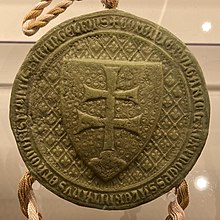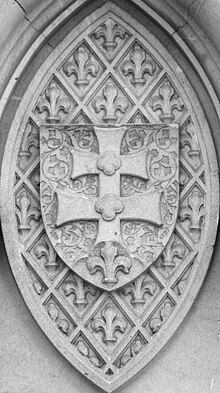Eskudo ng Hungriya
| Coat of arms of Hungary | |
|---|---|
 | |
| Versions | |
[[file:  |100px]] |100px]]The coat of arms may also be used in other historical forms.[1] | |
| Details | |
| Armiger | Hungary |
| Adopted | 3 July 1990[2] |
| Crest | Holy Crown of Hungary |
| Escutcheon | Barry of eight Gules and Argent, impaling Gules, on a trimount Vert a ducal coronet Or issuing therefrom a Patriarchal cross Argent |








Ang eskudo ng Hungriya (Hungaro: Magyarország címere) ay pinagtibay noong 3 Hulyo 1990, pagkatapos ng pagtatapos ng komunista. Ang mga sandata ay ginamit na noon pa, kapwa may Banal na Korona ng Hungary at walang Banal na Korona ng Hungary, kung minsan bilang bahagi ng isang mas malaki, mas kumplikadong baluti, at ang mga elemento nito ay nagsimula noong Middle Ages.
Ang kalasag ay nahahati sa dalawang bahagi:
- Ang dexter (ang kanang bahagi mula sa pananaw ng maydala, ang kaliwang bahagi mula sa viewer) ay nagtatampok ng tinatawag na Árpád stripes, apat na Gules (pula) at apat na Argent (pilak) mga guhitan. Ayon sa kaugalian, ang mga guhit na pilak ay kumakatawan sa apat na ilog: Duna (Danube), Tisza, Dráva, at Száva.[4]
- Ang makasalanan (ang kaliwang bahagi mula sa pananaw ng maydala, ang kanang bahagi mula sa viewer) ay binubuo ng isang Argent (pilak) double cross sa Gules (pula) base, nasa loob ng isang maliit na O (gintong) korona, ang korona ay inilalagay sa gitnang bunton ng tatlong Vert (berdeng) burol, na kumakatawan sa mga hanay ng bundok (trimount) Tátra, [[Mátra] ], at Fátra.
Sa ibabaw ng kalasag ay nakapatong ang Banal na Korona ni St. Stephen (Stephen I ng Hungary, István király), isang korona na nananatili sa gusali ng Parliament (Országház) sa Budapest ngayon.[5]
Kasaysayan
Kaharian ng Hungary
Ang pinakakaraniwang mga motif ng ikasiyam at unang bahagi ng ikasampung siglo -ang griffin, lobo at hind-sedom na pigura sa huling Hungarian iconography at heraldic symbolism, gayunpaman ang Hawk o Turul na sa shamanistic lore ay nakasalalay sa puno ng buhay na nag-uugnay. ang lupa na may netherworld at ang kalangitan na napanatili nang mas matagal bilang isang aparatong pagmamay-ari ng naghaharing bahay.[6]
Pasilip ng sanggunian
- ↑ "National Symbols: The Coat of Arms". www.keh.hu (sa wikang Ingles). Office of the President of the Republic. Inarkibo mula sa orihinal noong 25 September 2021. Nakuha noong 12 February 2017.
- ↑ "1990. évi XLIV. törvény a Magyar Köztársaság Alkotmányának módosításáról" [Act XLIV of 1990 on the Amendment of the Constitution of the Hungarian Republic]. hu.wikisource.org (sa wikang Unggaro). Nakuha noong 12 February 2017.
- ↑ Bertényi, Iván (1998). Új magyar címertan [New Hungarian heraldry] (sa wikang Unggaro). Budapest: Maecenas Könyvkiadó. ISBN 963-7425-81-0.
- ↑ Betsy Dru Tecco: How to Draw Hungary's Sights and Symbols, The Rosen Publishing Group, New York, 2005 [1]
- ↑ Betsy Dru Tecco: How to Draw Hungary's Sights and Symbols, The Rosen Publishing Group, New York, 2005 [2]
- ↑ Martyn C. Rady, Maharlika, lupain at serbisyo sa medieval Hungary, Palgrave Macmillan, 2000, p.12